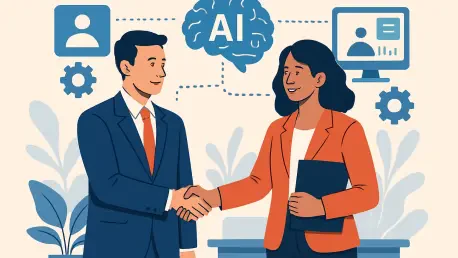In the fast-paced world of enterprise innovation, Generative AI (GenAI) stands as a beacon of transformation, promising to revolutionize industries with unprecedented efficiency and creativity. Yet, a staggering reality looms: studies reveal that nearly 80% of GenAI projects fail to move beyond the pilot stage, leaving businesses stranded in a sea of unrealized potential. This gap between ambition and execution raises a critical question: what holds these initiatives back, and how can strategic alliances turn the tide? The answer lies in partnerships—collaborations that bridge expertise gaps and pave the way for scalable success. This exploration delves into the heart of GenAI deployment struggles and uncovers how the right partners can transform stalled projects into game-changing solutions.
The significance of this challenge cannot be overstated. As companies race to integrate GenAI into their operations, the inability to scale beyond initial trials risks not just financial losses but also a diminished competitive edge in an AI-first era. With industries from healthcare to retail banking on GenAI for everything from personalized customer experiences to automated workflows, overcoming deployment hurdles is no longer optional—it’s a strategic necessity. Partnerships emerge as a linchpin in this journey, offering the tools, knowledge, and support needed to navigate a landscape fraught with technical and organizational obstacles. The following sections break down the core issues and illuminate the path forward through collaborative innovation.
Why Do GenAI Projects Stall at the Pilot Stage?
Many enterprises launch GenAI initiatives with high hopes, inspired by success stories of AI-driven transformation. However, a sobering trend persists: most of these projects grind to a halt after the pilot phase. The reasons often lie in a mismatch between expectations and reality—businesses underestimate the complexity of scaling AI solutions across diverse systems and teams. Without a clear roadmap or adequate resources, promising experiments become stranded, unable to deliver measurable impact.
Digging deeper, internal limitations play a significant role in this stagnation. A lack of in-house expertise in AI model customization or data integration frequently derails progress, as does insufficient infrastructure to support large-scale deployment. These hidden barriers turn initial enthusiasm into frustration, with pilot projects gathering dust instead of driving change. The potential for partnerships to address these gaps becomes evident, offering a lifeline to organizations struggling to move forward.
This persistent stall at the pilot stage signals a broader need for external support. Collaborations with experienced vendors or consultants can provide the missing pieces—be it technical know-how or strategic planning—that prevent projects from faltering. By setting the stage for a closer look at deployment challenges, it becomes clear that partnerships might just be the catalyst needed to break through these early roadblocks.
The Critical Importance of GenAI Deployment Today
In today’s business landscape, GenAI represents a transformative force, capable of automating repetitive tasks, enhancing decision-making, and unlocking new revenue streams. Industries like manufacturing use it to optimize supply chains, while financial services leverage it for fraud detection with remarkable precision. The potential to gain a competitive advantage through GenAI is undeniable, making its adoption a high-stakes endeavor for any forward-thinking enterprise.
Yet, the reality remains daunting—many companies find themselves trapped in pilot purgatory, unable to scale their AI initiatives. This failure to deploy at an enterprise level risks not only wasted investments but also missed opportunities in a market where AI adoption is rapidly becoming the norm. A report indicates that businesses failing to implement GenAI effectively could lose up to 30% of market share to competitors by 2027, underscoring the urgency of overcoming these barriers.
The stakes extend beyond mere technology adoption; they touch on strategic survival. Navigating GenAI deployment challenges is essential for maintaining relevance in an era where innovation dictates market leadership. This pressing need highlights why collaborative efforts with external partners are not just beneficial but imperative, ensuring that businesses can harness AI’s full potential without succumbing to early setbacks.
Unpacking the Five Major Barriers to GenAI Deployment
GenAI deployment faces a gauntlet of obstacles that can derail even the most promising initiatives. The first hurdle is selecting the right use case—many organizations squander resources on projects with low impact or feasibility. Partners with industry insight can steer efforts toward high-value applications, such as automating customer service responses, ensuring resources are allocated effectively.
Another critical issue is optimizing key performance indicators (KPIs) to measure success. Without well-defined metrics, GenAI projects often lose direction, failing to demonstrate value. External expertise helps align AI efforts with tangible outcomes, like a 20% increase in operational efficiency, providing clarity and focus. A notable example includes a retail firm that, with partner guidance, tied its AI chatbot deployment to reduced customer wait times, achieving significant satisfaction gains.
Additional challenges include preparing data assets, launching and maintaining solutions, and securing buy-in from employees and stakeholders. Data preparation doesn’t demand perfection but requires relevant context, which partners streamline by prioritizing quality over exhaustive cleansing. Technical rollout issues are mitigated through partner-supported deployment and monitoring, while stakeholder resistance is addressed via training and advocacy, as seen in a tech company where partner-led workshops boosted adoption rates by 40%. These collaborative solutions illustrate how partnerships tackle each barrier with precision and impact.
Expert Perspectives on the Value of Partnerships
Insights from industry leaders reinforce the indispensable role of partnerships in GenAI success. A recent survey by a leading tech research firm found that companies collaborating with external AI specialists achieved deployment timelines 35% faster than those going it alone. Such data highlights the efficiency gains that come from tapping into specialized knowledge and resources.
Beyond statistics, real-world experiences add depth to this narrative. A healthcare provider, struggling with employee skepticism toward a new GenAI diagnostic tool, partnered with a consultancy to conduct targeted training sessions. This initiative not only alleviated fears but also fostered enthusiasm, with staff reporting a 50% improvement in diagnostic accuracy post-implementation. Stories like these underscore the human element that partners help address alongside technical challenges.
Expert opinions further cement this viewpoint, with many AI strategists emphasizing that no single organization can master every facet of GenAI deployment independently. Collaboration brings together diverse strengths, from cutting-edge tech to change management skills, creating a robust framework for success. These voices of experience collectively affirm that partnerships are not a luxury but a cornerstone of effective AI integration.
A Step-by-Step Guide to Harnessing Partnerships for GenAI Success
Navigating GenAI deployment with a partner starts with identifying the right collaborator—one with proven expertise and alignment with specific industry needs. This initial step ensures that the partnership is built on a foundation of relevance and capability, setting the tone for a focused and effective collaboration.
Next, co-defining clear business goals and KPIs with the partner establishes a shared vision for the project. This process involves mapping out desired outcomes, such as reducing operational costs by 15%, to keep efforts aligned with strategic priorities. Following this, collaboration on data readiness focuses on accessibility rather than exhaustive perfection, streamlining preparation for quicker results.
The roadmap continues with planning a phased rollout, supported by the partner to ensure seamless launches and sustained maintenance. Finally, engaging employees early through workshops and transparent communication, facilitated by the partner, builds trust and adoption. This structured approach, grounded in practical steps, equips organizations to leverage partnerships effectively, turning GenAI challenges into opportunities for growth and innovation.
Looking back, the journey through GenAI deployment challenges revealed a landscape where ambition often outpaced execution, yet partnerships emerged as a powerful remedy. Reflecting on the countless stalled pilots, it became evident that collaboration with external experts bridged critical gaps in expertise and strategy. The structured frameworks and real-world successes of the past underscored a vital lesson: no enterprise needs to face these hurdles alone. Moving forward, businesses are encouraged to seek out partners who align with their vision, prioritize clear goals, and foster employee engagement from the outset. By taking these actionable steps, organizations can transform GenAI from a pilot-phase dream into a scalable reality, driving lasting impact in an ever-evolving digital era.









